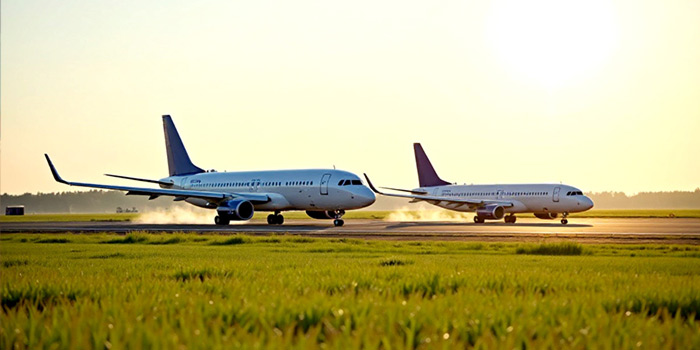Long-Haul, Low-Cost Airlines: Strategies for Success in 2025
22 Jul 2025
Highlights:
The long-haul, low-cost carrier (LCC) model has long walked a fine line between ambition and volatility. In 2025, that reality remains: while 14 airlines are currently operating low-cost long-haul services—defined as routes exceeding 3,400 nautical miles—only five of them have done so consistently since 2015. This figure speaks not only to the structural challenges facing long-haul LCCs, but also to the strategic clarity required to make the model work.

In an industry where distance typically dictates complexity and cost, success stories are emerging among operators who have resisted a one-size-fits-all approach. These carriers are winning not because they replicate legacy models at lower prices, but because they understand how to match differentiated product strategies, niche market targeting, and operational agility to a price-sensitive but growing global travel base.
Dual Brands, One Strategy
One of the defining patterns among surviving and thriving long-haul LCCs is the adoption of dual-brand strategies. These allow major carriers to tap into both the premium and budget segments without eroding brand equity or customer expectations.
The Qantas Group offers a clear example. With flagship Qantas catering to full-service travelers and Jetstar serving the budget-conscious market, the group effectively captures both ends of the spectrum. Jetstar's long-haul routes to Asia and the Pacific operate under a leaner cost base, while Qantas maintains premium service across intercontinental markets. This “airline-within-an-airline” model enables revenue maximization across market segments while providing operational flexibility and internal competition that drives efficiency.
Similarly, Singapore Airlines and its wholly owned low-cost subsidiary Scoot have perfected the balancing act. Scoot serves as a cost-effective vehicle to reach secondary cities and price-sensitive leisure markets, particularly across Asia and Oceania. By leveraging shared back-end systems, training platforms, and airport infrastructure, the group unlocks significant economies of scale—all while maintaining clear brand differentiation. As Scoot expands into Europe and the Middle East, it complements, rather than cannibalizes, its parent airline’s network.
Serving the Overlooked: Niche Market Specialists
While brand architecture is key, market selection is equally critical. Successful long-haul LCCs tend to avoid head-on competition with full-service incumbents in saturated markets. Instead, they build loyalty in underserved or demographically targeted corridors.
Cebu Pacific and Lion Air, two dominant low-cost players in Southeast Asia, illustrate this strategy well. Both have prioritized long-haul routes to the Middle East, tapping into consistent flows of migrant labor and religious travel. These markets—often neglected by global network carriers—provide stable, year-round demand with limited elasticity.
Likewise, Azul Brazilian Airlines has carved a niche in long-haul services between Brazil and diaspora-heavy destinations such as Florida and Portugal. Its network connects travelers visiting family or seeking cultural continuity, rather than relying solely on price-driven tourism. In this case, emotional and community ties underpin traffic patterns, reducing volatility and enabling stronger forward bookings.
Operational Flexibility: The Hidden Advantage
While traditional carriers have long operated with complex, segmented fleets, LCCs often rely on uniform aircraft types to streamline costs. Yet for long-haul low-cost operations, fleet flexibility has emerged as a quiet enabler of profitability.
Scoot’s mixed fleet of Boeing 787s and Airbus A320s allows the airline to shift capacity and frequency dynamically, depending on seasonal demand, geopolitical shifts, or sudden surges in leisure travel. This helps maximize aircraft utilization while optimizing yield on a per-route basis. The same is true of Jetstar, whose ability to deploy widebodies or narrowbodies based on route profiles gives it an operational nimbleness that many legacy peers lack.
For these airlines, operational flexibility is not merely about aircraft—it extends to crew scheduling, route planning, and maintenance cycles, all of which are tightly integrated to respond to market signals in real time.
Looking Ahead
The long-haul low-cost model is not for the faint of heart. With thin margins, long flight times, and fierce competition from established network carriers, failure can be swift. Yet, for those that embrace multi-brand positioning, address high-demand niche markets, and build adaptable operations, the model is far from untenable.
As we progress through 2025, long-haul LCCs are no longer simply experimental. They are evolving into credible disruptors, challenging conventional aviation economics and reshaping expectations around what it means to fly affordably—without sacrificing strategic depth.
At AviaPro Consulting Inc., we continue to monitor these developments closely as part of our commitment to guiding airlines through complex, global transformations. For carriers considering entry into or expansion within long-haul low-cost markets, the lessons are clear: know your customer, design for flexibility, and build for resilience.
Sources
“Qantas Group Case Study: Airline-within-Airline Model,” Qantas Group
“Scoot Launches New Europe Routes,” Scoot Media Centre
“Cebu Pacific Air Expands Long-Haul Services,” Cebu Pacific Newsroom
“Azul to Launch New Route to Portugal,” Azul Linhas Aéreas
AviaPro Internal Market Intelligence Reports, 2024–2025
AviaPro Newsroom
+1 416-544-9969
info@aviaproconsulting.com

Editorial Contacts